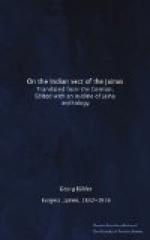The characteristic feature of this religion is its claim to universality, which it holds in common with Buddhism, and in opposition to Brahmanism. It also declares its object to be to lead all men to salvation, and to open its arms—not only to the noble Aryan, but also to the low-born [’S]udra and even to the alien, deeply despised in India, the Mlechcha. [Footnote: In the stereotyped introductions to the sermons of Jina it is always pointed out that they are addressed to the Aryan and non-Aryan. Thus in the Aupapatika Sutra Sec. 56. (Leumann) it runs as follows: tesi[.m] savvesi[.m] a[r.]iyamanariyana[.m] agilae dhammat[.m] aikkhai “to all these, Aryans and non-Aryans, he taught the law untiringly”. In accordance with this principle, conversions of people of low caste, such as gardeners, dyers, etc., are not uncommon even at the present day. Muhammadans too, regarded as Mlechcha, are still received among the Jaina communities. Some cases of the kind were communicated to me in A[h.]madabad in the year 1876, as great triumphs of the Jainas. Tales of the conversion of the emperor Akbar, through the patriarch Hiravijaya (Ind. Antiq. Vol. XI, p. 256), and of the spread of the Digambara sect in an island Jainabhadri, in the Indian Ocean (Ind. Ant. Vol. VII, p. 28) and in Arabia, shew that the Jainas are familiar with the idea of the conversion of non-Indians. Hiuen Tsiang’s note on the appearance of the Nirgrantha or Digambara in Kiapishi (Beal, Si-yu-ki, Vol. I, p. 55), points apparently to the fact that they had, in the North West at least, spread their missionary activity beyond the borders of India.] As their doctrine, like Buddha’s, is originally a philosophical ethical system intended for ascetics, the disciples, like the Buddhists, are, divided into ecclesiastics and laity. At the head stands an order of ascetics, originally Nirgrantha “they, who are freed from all bands,” now usually called Yatis—“Ascetics”, or Sadhus—“Holy”, which, among the [’S]vetambara also admits women, [Footnote:




